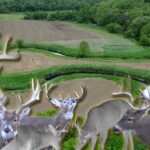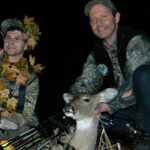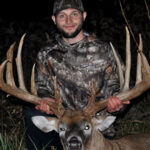Joel Turner shares the info you need to know before heading into bear country for your next hunt.
Are you hunting in grizzly country this year and wondering what handgun you should carry? You should know that handgun rounds are not very good at killin’ stuff!
Here’s why:
Most handguns that an archer would normally carry are not suited for actually causing immediate lethality. This is because handgun bullets simply travel too slowly.
There is a thing out there called Hydrostatic Shock. This is the pushing of water through organs. Traditional handgun rounds have a shock wave that pushes water through an organ at a rate that does not tear the organ.
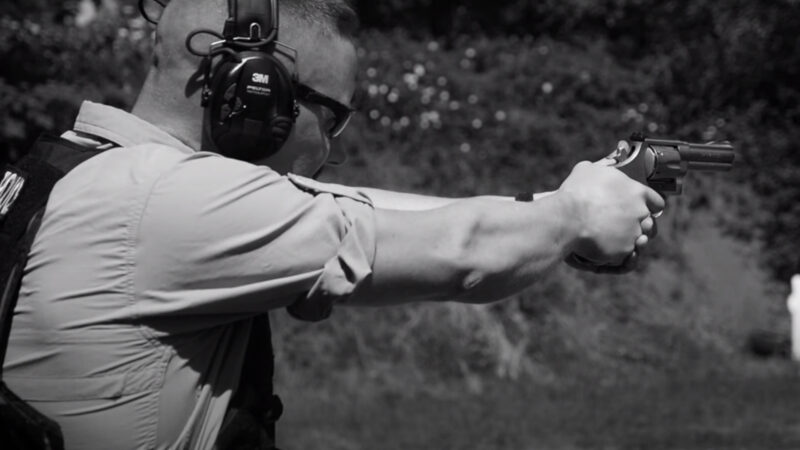
Rifle rounds, however, that travel over 2200 feet per second, push water at a rate that actually tears the organ. That is why rifle rounds are so lethal. Any impact with a rifle round near an organ that is hit by the shock wave will tear the organ.
The only flesh that is crushed with a handgun round is that flesh that is in the path of the leading edge of the handgun bullet. There is no hydrostatic shock with handgun rounds that strike the target at less than 2200 feet per second.
This leaves virtually all of the handguns that are convenient to carry in a realm of ineffectiveness in lethality in a time frame that could reduce you to bear feces!
The good news is, you don’t have to lug around that .50 AE Desert Eagle because it would be only slightly more effective than a much smaller 9mm in regards to lethality.
The bad news is, no matter what you carry, you probably have not practiced for the actual event of shooting at a charging target.
Knowing what we know about Hydrostatic Shock, your only goal with a handgun is to get the bear to change direction from toward you to away from you. This may result in an eventually dead bear, but it very rarely results in an instantly dead bear as we would hope.
I am imagining most people’s practice sessions with their nuclear magnum bear loads would be performed as such:
You have purchased a fancy holster that goes underneath your bino harness. You keep the holster tight to your body because you don’t want it flopping around on your chest while you are walking or interfering with your rangefinder pouch.
You square up on the target at a distance of about 10 yards because that is the line you have drawn in the sand. You are sure that if a bear gets this close in a charge you are going to lawfully utilize your handgun.

THE NEXT SEQUENCE OF EVENTS IS WHY MANY PEOPLE FAIL AT CHANGING THE DIRECTION OF THE BEAR!
In your practice, you pull the handgun out of the holster, then you point the handgun at the target, THEN FIND YOUR SIGHTS, then you put your finger on the trigger, then try as hard as you might to press the trigger slowly so you don’t shoot low and left as you always seem to do. Sound familiar?
This sequence of events is NOT what you are going to do with a charging bear. In an actual situation, you will yank the pistol from the holster and hopefully, it doesn’t get caught on your rangefinder bungee.
If you do get it successfully out of the holster, you will most likely point the pistol at the charging menace with your finger already on the trigger.
There will be no thought towards the sights and you will only see the frame of the handgun covering the bear.
You will shoot an unknown number of rounds at a rate that you have never practiced because most gun ranges don’t let you shoot more than one round per second. This is the natural cycle of motion that many find themselves performing whether they want to or not. This cycle of motion happens every day in police officer involved shootings around the globe.
So, to stay out of this cycle, what and how should we practice?
First of all, make sure you can get your handgun out of its carry position with both hands. You don’t know which hand will be in a bear’s mouth!
To do this, keep the handgun near your centerline and have the holster loose enough that you can get a firing grip on the handgun with either hand. For a right-handed shooter, you must be able to grip the pistol in the left hand and pull the holster around enough to dislodge the pistol and have a firing grip on the pistol.
Most holsters are too tight to the body which causes a shooter to pull the pistol out with a nonfiring grip and have to rotate the pistol in some fashion against their body or on the ground.
In a bear attack, this rotation outside the holster will most likely result in a dropped handgun. Once the handgun has been dislodged from the holster and a firing grip has been established, the make-or-break point is about to happen.

When the shooter pushes the handgun away from their body and presents the pistol to the target, they must have 3 things in place. By the time the shooter gets the pistol to full extension, they must have sight picture, sight alignment, and slack out of the trigger.
This is accomplished by placing the front sight of the pistol onto the target at half extension. Then, simply push the front sight into the target and the rear sight will fold up around the front sight with no further effort. This is based on the grip angle and the biomechanics of the human wrist.
Finding the front sight early in the push is key! THE PRACTICING OF THE PRESENTATION TO THE TARGET IS MORE IMPORTANT THAN PRACTICING THE ACTUAL SHOOTING OF THE HANDGUN!
This is because you are going to go open-loop (fast) on the trigger whether you like it or not. When you go open loop, there will be pre-ignition movements linked to the trigger motor program and you will flinch.
You don’t necessarily need to practice yanking the trigger. What does need to be practiced is minimizing the range of motion of these pre-ignition movements. This is done by placing 100% of your grip strength into the grip of the pistol. This cannot be over-emphasized.
Any percentage difference under 100% of the grip strength will come along with the trigger press and the impact point of the bullet will be changed.
To see this, squeeze your fist at 50% of your grip strength. While still in the 50% fist, squeeze your fist to 100% of your grip strength. That movement in your fist is linked to the trigger press and that is how it changes the point of impact.
So, practicing the straight push to target and having those three things in place by the time you get to full extension is of utmost importance. Please practice this motion to the point that anytime you get to full extension, your sights are lined up, they are on the target, and the slack is out of the trigger.
This must obviously be done safely and the motion is best learned in dry fire. When you become proficient at this motion, whatever you are looking at becomes your sight picture. Your sights will be on the target whether you see them or not. It has been proven thousands of times that you will probably NOT see your sights in a high-stress open-loop engagement.
In a bear attack, you are probably not going to instantly have lethal results with a handgun. If you have to shoot, put as many rounds into the bear’s face as possible. These hits have the highest likelihood of getting the bear to change direction.
Bullet skips off of a bear skull is a significant problem. Handgun rounds are very difficult if not impossible to get into the cranial cavity of a bear unless the bear is shot from a downward angle just in front of the ear from the top of the skull.
This newsletter was not written to scare you. It was written because I have seen too many people mauled by grizzlies that were ineffective with their handguns. If you are going to carry a handgun in grizzly country, you need to know the realities of the situation.
Practice the push. Give it 100% of your grip strength. Handgun rounds suck for killin’ stuff.
The skills mentioned in this newsletter and so much more are available in our new Precision Pistol Shooting online course.

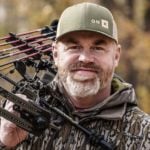 By
By 